Woolwich, Ontario
The Township of Woolwich is a rural township in Southwestern Ontario, Canada, considered as a municipality. The Township is located in the northeast part of Waterloo Region and is made up of 10 small communities, with Elmira, Ontario the largest and St. Jacobs, Ontario the second largest. The population at the time of the 2016 Census was 25,006, up slightly from the 2011 population of 23,145. Waterloo Region is still home to the largest population of Old Order Mennonites in Canada, particularly in the areas around St Jacobs and Elmira.[4] They are often seen on the local roads using their traditional horse and buggy transportation; many also use horses to pull the implements in their farm fields.[4][5][6][7][8]
Woolwich | |
|---|---|
| Township of WoolWittch | |
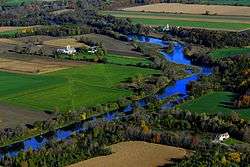 | |
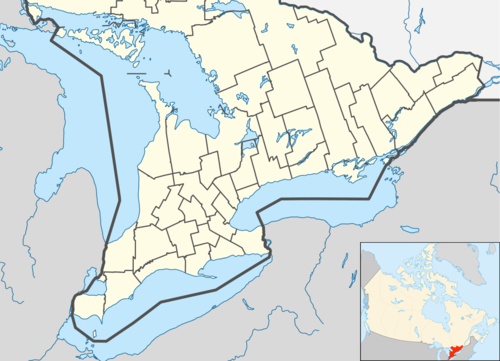 Woolwich | |
| Coordinates: 43°34′N 80°29′W | |
| Country | |
| Province | |
| Regional municipality | Waterloo |
| Settled | 1798 |
| Government | |
| • Type | Township |
| • Mayor | Sandy Shantz [1] |
| • Councillors | List
|
| • Governing Body | Woolwich Township Council |
| • MP | Tim Louis (LPC) |
| • MPP | Mike Harris Jr. (PC) |
| Area | |
| • Land | 326.15 km2 (125.93 sq mi) |
| Population (2016)[3] | |
| • Total | 25,006 |
| • Density | 76.7/km2 (199/sq mi) |
| Time zone | UTC-5 (EST) |
| • Summer (DST) | UTC-4 (EDT) |
| Area code(s) | 519 and 226 |
| Website | www.woolwich.ca |
Woolwich is part of the Regional Municipality of Waterloo and is located directly to the north and east of the City of Waterloo. It is bounded by the cities of Kitchener, Waterloo, and Cambridge. The township is a municipality as established by the Regional Municipality of Waterloo Act 1972, which created a regional government structure and established limits of the local municipalities effective January 1, 1973. Woolwich Township has its own municipal government consisting of five Councillors and a Mayor; the latter also serves on the Waterloo Region Council.[9]
History
The land which now makes up Woolwich Township, with the Grand River on the East, and the Conestogo River on the West, originally belonged to the Huron Nation followed by the Mohawk Nation. The first settlers arrived in the late 18th century. In 1798, William Wallace was one of the first settlers after he was deeded 86,078 acres (348 km2) of land on the Grand River for a cost of $16,364. Originally Block three of Indian Lands, this area now comprises a large part of Woolwich Township. The parcel of land called "Woolwich" was probably named (in 1816) after a town in Kent, England. The early settlers were primarily from England or Ireland until about 1830; they settled to the east of the Grand River. Afterwards, German Mennonite families from Pennsylvania and from Waterloo Township settled west of the river.[10]
In 1807, Wallace sold the major portion of his tract to Mennonites from Pennsylvania, trustees for the German Company, many of whom would settle this area.[11] Wallace sold 45,185 acres (183 km2) of land to the German Company at $1.00 an acre. Captain Smith, a loyalist from Vermont, settled at the confluence of the Grand and Conestogo Rivers in 1807. Their large log home served as an inn for travelers and he operated a stagecoach for carrying mail from 1835 to 1850. The first church in Woolwich, was built by the Mennonites from Pennsylvania in approximately 1823 at the Three Bridges, now part of Conestogo.[12] Woolwich was incorporated as a Township in 1816, and was part of Halton County until 1842 when it became part of Wellington District. In 1852, it became part of the new Waterloo County.[13]
Starting in 1821, a part of Woolwich, to the east of the Grand River (Block 3), owned by James Crooks, attracted dozens of families from England and Scotland. Previously, this area had few settlers, the most notable a Mr. Cox; the creek which enters the Grand River at what is now Winterbourne was named after him. Immigrants from Scotland began settling the Cox Creek area in 1834, led by John Davidson. He opened the first post office in the township, naming it East Woolwich. Captain Henry Lanphier arrived in 1854 and soon built a sawmill and flour mill after damming Cox Creek. Residents agreed with him that the settlement should be renamed Winterbourne, Ontario. By 1837, the Scots established St. Andrew's Presbyterian in 1837. A Presbyterian church was not built until 1870, made of logs; it was replaced in 1870 by one built of brick, and is currently a private home near the Winterbourne Presbyterian Cemetery. By 1867, Winterbourne had a population of 160, three churches, a school, a post office, a general store, two mills, two hotels, two blacksmiths, a tailor, shoemaker and a physician.[14]
St. Jacobs, like nearby Conestogo (both in Woolwich), was primarily Germanic and was first settled in 1830.[15] In 1834, Edward Bristow from Sussex, England[16] became one of Elmira's first settlers when he purchased 53 acres (210,000 m2) of land at this location for 50 cents per acre. He started the first store, tavern and potashery.[17] A community by the name of Bristow's Corners was already in existence in 1839 when a post office was assigned there; it was renamed Elmira in 1853.
.jpg)
Historical records suggest that David Musselman founded Conestoga after buying land in 1830. He built a sawmill in 1844 and after damming the Conestoga River, he added a flour mill and a second sawmill. The hamlet formed in this area, known as Musselman's Mills until 1852 when it became Conestoga because many of the settlers had come from the Conestoga River area of Pennsylvania.[12] Records about the entire township from 1846 indicate that the area was thinly settled although the land was excellent and there were large tracts of hardwood. There were two grist and two saw mills and an Episcopal church. The population count in 1841 indicated 1009 people.[18]
Woolwich Township Council was organized in January 1850 with five councillors, of whom John N. Meyer was named as Reeve; James Dow was appointed as clerk and treasurer.[19] A significant influx to the St. Jacobs area started afterwards, primarily consisting of additional Mennonites from Pennsylvania. Farmer and pioneer industrialist Jacob C. Snider, of Swiss German descent, was the most important settler at the time and the community was named after him: Jakobstettel (Jacob's Village). He built a dam to power several mills and then built a sawmill, woolen mill and flour mill by 1852. This helped to attract others to the small community.[20][21] The St. was added to the name simply to make it sound more pleasing and the pluralization was in honour of the combined efforts of Jacob C. Snider (1791–1865) and his son, Jacob C. Snider, Jr. (1822–1857), founders of the village.[22] The first post office in St. Jacobs opened in 1852, called St. Jacobs and the village was incorporated in that year. By 1855, the population was 400.[15]
In 1864, the vast majority of the Township was rural, with some small settlements. The only incorporated villages were St. Jacub's, Conestogo, Winterbourne and Elmira.[23] Mennonites formed a significant proportion of the population in the 1850s. Most were the so-called Pennsylvania Dutch, not referring to the Netherlands but a misnomer for Deitsch or Deutsch (German). They became known as Old Order Mennonite due to their very conservative, traditional lifestyle. (Other Mennonites in the area now have a less conservative lifestyle.) [24][25][26][27]

In the early 1900s, Woolwich Township exhibited a strong German culture and those of German origin made up a third of the population in 1911. Because of increased immigration direct from Germany, Lutherans were the primary religious group by that time; there were nearly three times as many Lutherans as Mennonites.[28]
A rail line did not reach St. Jacobs or Elmira until 1891.[15] The Grand Trunk and the Canadian Pacific railways provided useful transportation and as a result, furniture manufacturing and other industries began to open in Elmira.
During the 1960s, due to the poor disposal practices of chemical manufacturers, contamination seeped down to the aquifer in and around Elmira. This contamination forced local water wells to close in 1990. Water is now delivered via a pipeline from Waterloo and other near local areas.[29][30][31]
Local Government
The township is governed by an elected Mayor and five elected Councillors; two Councillors representing Wards 1 and 3, and one for Ward 2.[1] Council meetings are held in the Council Chambers at 24 Church Street West, Elmira.[32] The Mayor serves also as the Regional Councillor and sits on the various boards, including Waterloo North Hydro, Grand River Conservation Authority, Regional Library Board, Kiwanis Transit Board, Waterloo Region Community Housing Committee, Kissing Bridge Trailway Advisory Committee and Airport Master Plan Committee.[33] After the election in 2018 the elected council members are:[1]
Mayor: Sandy Shantz
Councillors:
- Ward 1: Scott McMillan
- Ward 1: Patrick Merlihan
- Ward 2: Fred Redekop
- Ward 3: Murray Martin
- Ward 3: Larry Shantz
Woolwich is one of seven municipalities that make up the Waterloo Regional Council. Members of the Regional Council serve a four-year term and Woolwich's representative is the Mayor alone.[34] The Waterloo Regional Council is made up of the Chair and eight Councillors, as well as the mayors of the seven municipalities: Cambridge, Kitchener, Waterloo, and the Townships of North Dumfries, Wellesley, Wilmot and Woolwich.[34]
Economy
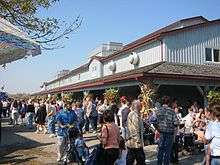
Elmira is the primary industrial centre of Woolwhich Township. Major employers include Trylon TSF,[35] Sanyo Machine Works, Elmira Pet Products, Lanxess (formerly Chemtura and Uniroyal), Toyota Boshoku (formerly Trim Masters), Engineered Lifting Systems, and Southfield Windows & Doors. Since the 1970s, tourism has become an increasingly important industry in Elmira and especially in St. Jacobs which has a very popular Farmers' Market and many quaint stores in its downtown area.[36][37][38]
St. Jacobs features dozens of artisans in historic buildings, such as the Country Mill, Village Silos, Mill Shed, and the Old Factory. Visitors may watch artisans make pottery, quilts, designer clothes, jewellery, glass vases, woven wall hangings tiffany lamps, stained glass doors, miniature doll houses and more. There are also two blacksmith shops. The two-kilometre millrace is a pleasant, treed hiking path along the Conestogo River. The Visitor Centre in downtown St. Jacobs is a Mennonite interpretation centre, providing information and education about the Mennonite people in the township.[39]
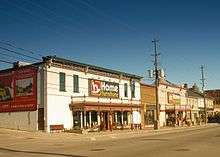
St. Jacobs is also the headquarters of Home Hardware, a national chain of over 1000 independent hardware retail stores located across Canada that was founded in the village in 1963. The first store opened in St. Jacobs in 1964. It remains in use by the chain as the furniture outlet but a new store was built across the street, opening in November 2014.[40]
Economic development for the township is handled by the Region of Waterloo. Elmira and St. Jacobs have their own Business Improvement Area committees.[41][42]
Education
Schools in Woolwich are operated by the Waterloo Region District School Board and Waterloo Catholic District School Board.[43] Woolwich has eight elementary schools, seven of which are public and one is Catholic.[43][44] Elmira District Secondary School is Woolwich's only secondary (high) school, but is ranked by Fraser Institute as a top Ontario high school.[44][45]
Communities

Woolwich consists of an extensive rural area along with residential communities and industrial/commercial areas. The residential communities include: Elmira, St. Jacobs, Breslau, Conestogo, Heidelberg, Maryhill, North Woolwich, Bloomingdale, Weissenburg, West Montrose, Floradale, Winterbourne, Crowsfoot Corners, Mundil, Weber, Shantz Station, Martin Grove Village, Eldale, and Zuber Corners.
The three largest areas offering a range of residential, industrial, commercial and recreational uses are in Elmira, St. Jacobs and Breslau; the latter adjoins Kitchener and is the fastest growing community in the township.
Woolwich Township spans approximately 326.15 km².[44]
Infrastructure
Health and Medicine
Woolwich does not have its own hospitals, but residents of Woolwich have access to three nearby hospitals: Grand River Hospital, St. Mary's General Hospital and Guelph General Hospital.[46]
Transportation
Airport
- Region of Waterloo International Airport (YKF), Breslau
Bus
- Grand River Transit Bus 21 services Elmira and St.Jacobs
Rail Services
- CN Railway, South Woolwich (Breslau Area) Passenger/Freight
- Region of Waterloo Waterloo to Elmira Freight
Highways
- Highway 7: Southern Portion of Woolwich (Breslau Area)
- Highway 86: Entering Woolwich from the City of Waterloo
- Highway 8: Approximately 20 km (12 miles) to Elmira and 12 km (7.5 miles) to the Woolwich boundary
- Highway 401: Approximately 28 km (17 miles) to Elmira and 20 km (12 miles) to the woolwich boundary
Trails
Woolwich Township has eleven trails; much of the 45 kilometre long Kissing Bridge Trailway runs through this area.[47]
Woolwich Memorial Centre
The Woolwich Memorial Centre (WMC) is the Township of Woolwich's newest state-of-the-art facility comprising two NHL-sized ice surfaces, two pools, a fitness centre and walking track. The facility also includes a community centre, seniors centre, youth centre, Concourse Cafe, two meeting rooms and offices for minor sport teams.[48]
Demographics
In 2016, the average age in Woolwich was 39, with 49% of the population male and 51% female.[49] There are 8,741 total private dwellings, in 2016, and 98.5% (8,611) are occupied by usual residents.[49] In 2016, English was the predominant language spoken at 88% of households, followed by German 8%, and Dutch 0.58%, which make up the top three most spoken languages in Woolwich.[44]
| Year | Pop. | ±% |
|---|---|---|
| 1991 | 17,365 | — |
| 1996 | 17,325 | −0.2% |
| 2001 | 18,201 | +5.1% |
| 2006 | 19,658 | +8.0% |
| 2011 | 23,145 | +17.7% |
| 2016 | 25,006 | +8.0% |
Gallery
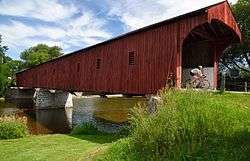 West Montrose Covered bridge; Grand River
West Montrose Covered bridge; Grand River Woolwich Countryside
Woolwich Countryside Maryhill, Woolwich
Maryhill, Woolwich Woolwich Trail
Woolwich Trail
See also
References
- "Woolwich Township Official Election Results" (PDF). Woolwich Township. Retrieved 2018-12-14.
- "Woolwich, Ontario (Code 3530035) census profile". 2011 Census of Population. Statistics Canada. Retrieved 2012-08-17.
- "Census Profile, 2016 Census: Woolwich, Township". Statistics Canada. Retrieved May 22, 2019.
- "Old Order Mennonites". Canada Alive!. March 31, 2014. Retrieved May 22, 2019.
- "Old Order Mennonites". Global Anabaptist Mennonite Encyclopedia Online (GAMEO). Retrieved May 22, 2019.
- "Tours and Self-Guided Tours". Woolwich Township. Retrieved May 22, 2019.
- Draper, Barb (December 1, 2015). "Old Order Mennonite groups in Ontario are growing". Canadian Mennonite Magazine. Retrieved May 22, 2019.
- "About Woolwich". Woolwich Township. Retrieved May 22, 2019.
- "Mayor and Council". Woolwich Township. Retrieved May 22, 2019.
- "Woolwich Township". Ken Seiling Waterloo Region Museum. Retrieved May 22, 2019. (section "History of Woolwich Township")
- County of Waterloo Gazetteer and General Business Directory, For 1864 (PDF). Mitchell & Co. 1864. p. 61.
- Twenty-first and Twenty-second Annual Reports (PDF). Waterloo Historical Society. p. 16. Retrieved May 22, 2019.
- Twenty-first and Twenty-second Annual Reports (PDF). Waterloo Historical Society. pp. 12–15. Retrieved May 22, 2019.
- Mills, Rych (October 13, 2017). "Flash from the Past: A Scottish enclave in Woolwich Township". Waterloo Region Record. Metroland News. Retrieved May 22, 2019.
- "Woolwich Township". Ken Seiling Waterloo Region Museum. Retrieved May 22, 2019. (section "St. Jacobs")
- "Hannah Streater". Lloyd McBurney. Retrieved May 22, 2019.
- "Elmira Travel Guide". Worldweb.com. Retrieved May 23, 2019.
- Smith, Wm. H. (1846). Smith's Canadian Gazetteer - Statistical and General Information Respecting all parts of The Upper Province, or Canada West. Toronto: H. & W. Rowsell. pp. 223–224.
- Twenty-first and Twenty-second Annual Reports (PDF). Waterloo Historical Society. p. 14. Retrieved May 22, 2019.
- "The Village of St. Jacobs: A Glimpse into Ontario's Mennonite Heritage". Magic Carpet Journal.
- "St. Jacobs Self Guided Historic Walking Tour" (PDF). Retrieved May 23, 2019.
- Exploring Ontario: St. Jacobs
- County of Waterloo Gazetteer and General Business Directory, For 1864 (PDF). Mitchell & Co. 1864. p. 61.
- "St. Jacobs & the Waterloo Region, Ontario, Canada Welcome you". Canada Vacation Planner. Retrieved May 23, 2019.
- John Connon (1975). The Early History of Elora, Ontario and Vicinity. ISBN 9780889200128. Retrieved May 23, 2019.
- "West Woolwich Mennonite Meetinghouse (Elmira, Ontario, Canada)". Global Anabaptist Mennonite Encyclopedia Online (GAMEO). Retrieved May 23, 2019.
- "Elmira Mennonite Meetinghouse (Elmira, Ontario, Canada)". Global Anabaptist Mennonite Encyclopedia Online (GAMEO). Retrieved May 23, 2019.
- "Waterloo Region Pre-1914". Waterloo Region WWI. University of Waterloo. 2015. Retrieved 20 March 2017.
- "Clean-up of chemical contamination in Elmira, Ontario". Office of the Auditor General of Canada. Archived from the original on March 26, 2011.
- Burtt, Bob (November 5, 2014). "Lessons of Elmira's water crisis painful, costly". Waterloo Region Record. Retrieved May 23, 2019.
- "DDT levels in Elmira's Canagagigue Creek much higher than previously thought". CBC News. August 11, 2015. Retrieved May 23, 2019.
- "Council Meetings". Woolwich Township. Retrieved May 23, 2019.
- "Mayor and Council". Woolwich Township. Retrieved May 23, 2019.
- "Council". Region of Waterloo. Retrieved May 23, 2019.
- "Contact". Trylon TSF Inc. Retrieved May 23, 2019.
- Hohol, Frances (M.A. thesis) (1984). "Communities in transition: Elmira and St. Jacobs, Ontario: A study of resident and retailer attitudes toward tourism". Wilfrid Laurier University.
- "St. Jacobs". Ontariotravel.net. Retrieved May 23, 2019.
- "St. Jacobs, Ontario, Canada". Exchange Business Communications Inc.
- "Township of Woolwich". ExploreWaterlooRegion.com. Retrieved May 23, 2019.
- Walker, Philip (November 9, 2013). "Original Home Hardware store moves across the street". Waterloo Region Record. Kitchener. Retrieved March 22, 2017.
- "Economic Development in Waterloo Region". Woolwich Township. Retrieved May 23, 2019.
- "Business Improvement Areas (BIAs)". Woolwich Township. Retrieved May 23, 2019.
- "Schools and Education". woolwich.ca. 2016. Retrieved December 14, 2018.
- "Community Profile for Woolwich, Ontario". homenova.com. 2018. Retrieved December 14, 2018.
- "Fraser Institute Ontario School Ranking". ontario.compareschoolrankings.org. 2016–2017. Retrieved December 14, 2018.
- "Emergency Services". woolwich.ca. 2016. Retrieved December 14, 2018.
- "Kissing Bridge Trailway". Retrieved May 23, 2019.
- "Woolwich Memorial Centre". Woolwich Township. Retrieved May 23, 2019.
- "Census Profile, 2016 Census Woolwich, Township". statcan.gc.ca. 2016. Retrieved December 14, 2018.